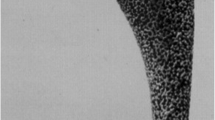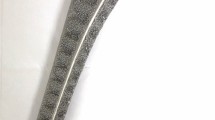Abstract
Introduction
Optimal fixation of cementless total hip stems is essential for long-term survival rates.
Aim
The purpose of this prospective study was to evaluate the early clinical and radiological outcomes of two new total hip stems with metaphyseal (Symax®) and predominantly diaphyseal (Hipstar®) anchoring principles in comparison to the well-established straight Zweymueller (SL-Plus®) stem.
Method
Clinical and radiological evaluations of 74 patients were undertaken preoperatively as well as at 6 and 12 months postoperatively using the Harris Hip Score (HHS) and Western Ontario and McMaster Universities-Score.
Results
During follow-up no stem had to be revised. The mean preoperative HHS of the three study groups amounted to 54.6 ± 15.7 points. At the 12 months follow-up the mean HHS in the SL-Plus group (n = 22) was 88.3 ± 10.5 points, in the Hipstar group (n = 25) 83.3 ± 15.0 and the in Symax group (n = 27) 83.6 ± 15.1. Due to stress shielding the straight Hipstar stem revealed radiolucent lines in the proximal Gruen zones of about 60%, whereas the SL-Plus stem showed significantly more radiolucent lines (87%). However, subsequent long-term studies must be carried out in order to clarify if the progression of radiolucent lines may influence the clinical result and implant longevity.






Similar content being viewed by others
References
Nercessian OA, Wu WH, Sarkissian H (2001) Clinical and radiological results of cementless AML total hip arthroplasty in young patients. J Arthroplasty 16:312–216
Nourbash PS, Paprosky WG (1988) Cementless femoral design concerns. Rationale for extensive porous coating. Clin Orthop Relat Res 355:189–199
Kircher J, Bergschmidt P, Bader R, Kluess D, Besser-Mahuzir E, Leder A, Mittelmeier W (2007) The importance of wear couples for younger endoprosthesis patients. Orthopade 36:337–346
Racey SN, McCaskie AW, Jones E, Birch MA (2004) Iron and alumina grit blasted TMFZ alloys differentially regulate bone formation in vitro. Eur Cell Mater 7(Suppl 1):81
Schuh A, Uter W, Holzwarth U, Kachler W, Goske Raab B, Knetsch T (2005) Residual particle-free rough surfaces after rough blasting with steel grit in total hip arthroplasty. Biomed Tech 50:404–407
Antonio JA, Capello WN, Manley MT, Geesink R (2001) Hydroxyapatite femoral stems for total hip arthroplasty: 10- to 13-year follow-up. Clin Orthop Relat Res 393:101–111
Diehl P, Hantke B, Hennig M, Tschesche H, Mittelmeier W, Schmitt M, Muehlenweg B (2004) Protein expression of MMP-13, uPA, and PAI-1 in pseudocapsular and interface tissue around implants of loose artificial hip joints and in osteoarthritis. Int J Mol Med 13:711–715
Siebold R, Scheller G, Schreiner U, Jani L (2001) Long-term results with the cement-free Spotorno CLS stem. Orthopade 30:317–322
Traulsen FC, Hassenpflug J, Hahne HJ (2001) Long-term results with cement-free total hip prosthesis (Zweymüller). Z Orthop Ihre Grenzgeb 139:206–211
Schramm M, Keck F, Hohmann D, Pitto RP (2000) Total hip arthroplasty using an uncemented femoral component with a taper design: outcome at 10-year follow-up. Arch Orthop Trauma Surg 120:407–412
Zweymueller K, Lintner F, Semlitsch M (1988) Biologic fixation of a press-fit titanium hip joint endoprosthesis. Clin Orthop Relat Res 235:195–206
Garcia-Cimbrello E, Cruz-Pardos A, Madero R, Ortega-Andreu M (2003) Total hip arthroplasty with use of the cementless Zweymüller Alloclassic system. J Bone Joint Surg 85A:296–303
Zweymueller K (1986) A cementless titanium hip endoprosthesis system based on press-fit fixation: basic research and clinical results. Instr Course Lect 35:203–225
Prymka M, Vogiatzis M, Hassenpflug J (2004) Primary rotatory stability of hip endoprostheses stems after manual and robot assisted implantation. Z Orthop 142:303–308
Harris WH (1969) Traumatic arthritis of the hip after dislocation and acetabular fractures: treatment by mold arthroplasty. J Bone Joint Surg 51A:737–755
Bellamy N, Buchanan W, Goldsmith CH, Campbell J, Stitt LW (1988) Validation study of WOMAC: a health status instrument for measuring clinically important patient relevant outcomes to antirheumatic drug therapy in patients with osteoarthritis of the hip and the knee. J Rheumatol 15:1833–1840
Bergschmidt P, Bader R, Finze S, Ansorge S, Kundt G, Mittelmeier W (2008) Bicondylar knee arthroplasty—influence of preoperative functional restriction on early functional postoperative outcome. Z Orthop Unfall 146:344–351
Gruen TA, McNeice GM, Amstutz HC (1979) Modes of failure of cemented stem-type femoral components: a radiographic analysis of loosening. Clin Orthop Relat Res 141:17–27
Brooker AF, Bowerman JW, Robinson RA, Riley LH (1973) Ectopic ossification following total hip arthroplasty. Incidence and method of classification. J Bone Joint Surg 55:1629–1632
Engh CA, Bohyn JD (1978) Porous coated hip replacement: the factors governing bone ingrowth, stress shielding, and clinical results. J Bone Joint Surg 69B:45–55
Bülow JU, Scheller G, Arnold P, Synatschke M, Jani L (1996) Follow-up (6–9 years) results of the uncemented CLS spotorno stem. Arch Orthop Trauma Surg 115:190–194
Nilsdotter AK, Petersson IF, Roos EM, Lohmander LS (2003) Predictors of patient relevant outcome after total hip replacement for osteoarthritis: a prospective study. Ann Rheum Dis 62:923–930
Aarons H, Hall G, Hughes S, Salmon P (1996) Short-term recovery from hip and knee arthroplasty. J Bone Joint Surg 78B:555–558
van der Wal BC, de Kramer BJ, Grimm B, Vencken W, Heyligers IC, Tonino BJ (2008) Femoral fit in ABG-II hip stems, influence on clinical outcome and bone remodeling: a radiographic study. Arch Orthop Trauma Surg 128(10):1065–1072
Huiskes R (1993) Stress shielding and bone resorption in THA: clinical versus computer-stimulation studies. Acta Orthop Belg 59:118–129
Bugbee WD, Culpepper WJII, Engh CA Jr, Engh CA Sr (1997) Long-term clinical consequences of stress-shielding after total hip arthroplasty without cement. J Bone Joint Surg 79A:1007–1012
Author information
Authors and Affiliations
Corresponding author
Rights and permissions
About this article
Cite this article
Bergschmidt, P., Bader, R., Finze, S. et al. Cementless total hip replacement: a prospective clinical study of the early functional and radiological outcomes of three different hip stems. Arch Orthop Trauma Surg 130, 125–133 (2010). https://doi.org/10.1007/s00402-009-0907-8
Received:
Published:
Issue Date:
DOI: https://doi.org/10.1007/s00402-009-0907-8




